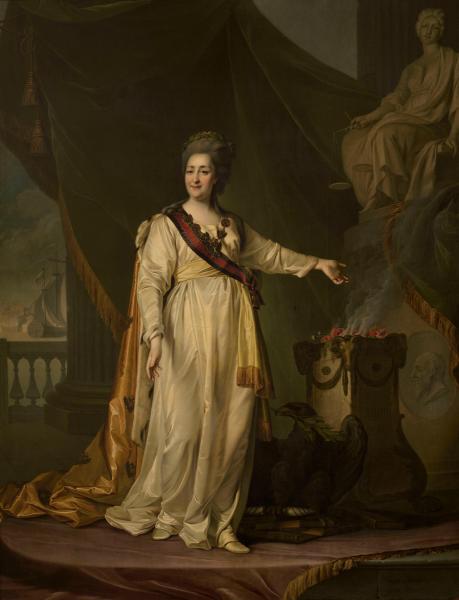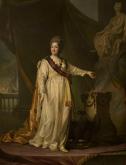Portrait of Catherine II the Legislatress in the Temple of the Goddess of Justice
Iconographic type of Fyodor Rokotov (between 1769 and 1777). 1783
- Period 18th century
- CategoryPortrait
- Share
Catherine the Great is depicted in a mantel with the chain of St Andrew and the ribbon and cross of St Vladimir.
Empress Catherine II of Russia (1729–1796): Princess Sophie Auguste Friederike of Anhalt-Zerbst. Married the heir to the Russian throne — Prince Karl Peter Ulrich of Holstein-Gottorp (1745). Overthrew her husband Emperor Peter III (1761–62). Crowned Empress (1762). Russian Museum: From Icons to the Modern Times. Palace Editions, St Petersburg, 2015. P. 94.
Catherine II (the Great; 1729–1796), née Princess Sophie Friederike Auguste von Anhalt-Zerbst-Dornburg, was born in the Prussian city of Stettin. In 1744, she arrived in Russia as the bride of Grand Duke Pyotr Fyodorovich, the future Emperor Peter III. That same year, she converted to Russian Orthodoxy and took the name Ekaterina Alexeevna. She married Pyotr Fyodorovich in August 1745. In 1754, she gave birth to an heir, the future Emperor Paul I. The relationship with her husband did not work out, and he planned to have her sent to a convent. In the summer of 1762, she led a conspiracy with his guards and overthrew Peter III, becoming Empress. In the first years of her reign, she adhered to a policy of "enlightened absolution", but after the peasant rebellion led by Emelyan Pugachev (1773–1775) and the French Revolution (1789), she was forced to toughen her regime. She led victorious campaigns against Turkey (1768‒1774; 1787–1792) and Sweden (1788–1790). During her reign, Crimea (1783), the Northern Baltic Sea, the Baltic states, the eastern part of Poland and the Aleutian Islands became part of Russia. Russian settlements were established in Alaska. Russia's prestige in Europe increased manifold. Catherine II is depicted with the Order of St Andrew (ribbon, star and cross).

